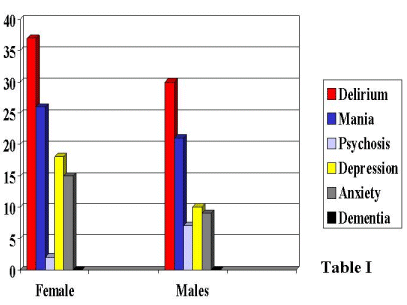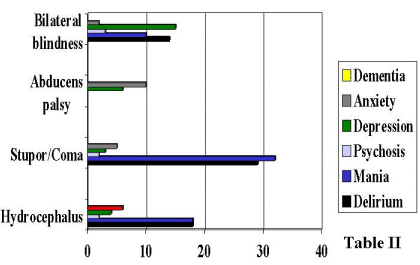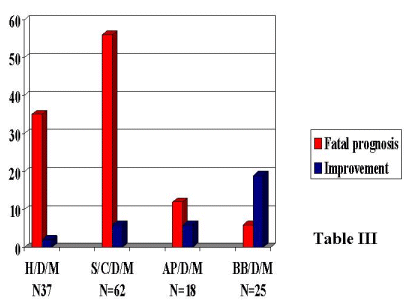Repositorio de Artículos | Congreso Virtual Internacional de Psiquiatría, Psicología y Salud Mental (Interpsiquis) | VII Edición | 2006
Manifestaciones neuropsiquiátricas en pacientes con meningitis a cryptococcus.
Autor/autores: L. de F. Ibañez-Valdes
RESUMEN
Background. Little is known about the prognostic value of some neuropsychiatry manifestation (npm) in hiv-patients with crytococcal meningitis (cm).
Objectives: to determine the prognostic value of some npm associated with cm and other neurological complications.
Patients and method: a retrospective analysis of 142 patients fulfilling the diagnostic criteria for cm and severe immune suppression (cd4<100 cell/mm3) was done. We identified clinical manifestations of depression, delirium, mania, anxiety, psychosis and dementia.
Results: the commonest npm on this series was delirium (47%) and manic episodes (33 %) followed by depression and anxiety (19 and 16 %). Dementia was not identified on this group.
Conclusions: serial lumbar punctures contributed to improve npm such as: delirium and mania however similar patients with an associated decrease level of consciousness (stupor/coma) for more than 48 hours or associated hydrocephalus had fatal prognosis (p<0. 001)
Palabras clave: Manifestaciones neuropsiquiátricas, meningitis, cryptococcus
Tipo de trabajo: Conferencia
Área temática: Neurocognitivos, Trastornos neurocognitivos .
Manifestaciones neuropsiquiátricas en pacientes con meningitis a cryptococcus.
Ibañez-Valdes L de F; Foyaca-Sibat H.
University of Transkei
Resumen
Background. Little is known about the prognostic value of some neuropsychiatry manifestation (npm) in hiv-patients with crytococcal meningitis (cm).
Objectives: to determine the prognostic value of some npm associated with cm and other neurological complications.
Patients and method: a retrospective analysis of 142 patients fulfilling the diagnostic criteria for cm and severe immune suppression (cd4<100 cell/mm3) was done. We identified clinical manifestations of depression, delirium, mania, anxiety, psychosis and dementia.
Results: the commonest npm on this series was delirium (47%) and manic episodes (33 %) followed by depression and anxiety (19 and 16 %). Dementia was not identified on this group.
Conclusions: serial lumbar punctures contributed to improve npm such as: delirium and mania however similar patients with an associated decrease level of consciousness (stupor/coma) for more than 48 hours or associated hydrocephalus had fatal prognosis (p<0. 001)
Introduction
Background and objectives: the incidence of crytococcal meningitis (cm), formerly a relatively rare disease, has markedly increased in recent years due to the frequent occurrence of the opportunistic infection in human immunodeficiency virus (hiv)-positive patients1 mainly in places where protease inhibitor, nucleoside reverse transcriptase, and non-nucleoside reverse transcriptase drugs remains unavailable. The fungus is acquired by inhalation and causes the initial lesion in the lungs; the pulmonary stage of infection is usually a symptomatic. The fungus disseminates in debilitated patients, usually involving the meninges. In hiv-negative patient’s incidence of cm is related to immunosuppressive drugs used to prevent allograft rejection in organ transplanted recipients, and particularly steroids therapy seems to be associated with an increased risk factor for cm2
Neuropsychiatry manifestations (npm) may be conditions that are directly attributed to hiv infection but sometimes these conditions existed before a person becomes hiv-positive and both contribute to increase level of unemployment, poverty, homeless and unhappiness. Patients presenting these conditions (npm-hiv) are more prompt to develop complications because most of them have limited access to health care, hiv primary care, new antiretroviral medications and poor compliance therefore they will have shortened hiv-related survival, severely impaired quality of life and worst prognosis compared with hiv patients without npm1. In places where traditional believes and stigmas are strong enough to modify the environment of these patients the prognosis is even worst. We recognize that despite all the scientific progress observed in the last century, the npm, epilepsies, and cognitive disorders are still surrounded by a mysterious mist for the majority of the population, mainly in developing countries, 3, 4, 5, 6 we also agree that it is abominable see at the beginning of the third millennium; npm and epilepsy are still being considered as symptom of devilish possession by some alternative therapists, adherent to distinct creeds in many societies around the world7
Based on our previous knowledge of this problem we selected a number of record from patients diagnosed as cm and hiv/aids with the aim to identify their npm and to determine any possible correlation between npm, complications, and clinical prognosis.
Material and method
A total of 142 patients with cm presenting npm, admitted in medical wards of Umtata general hospital between December 09, 2003 and December 09, 2004 were selected retrospectively. The detailed clinical history of the patients regarding age, sex, clinical diagnosis, and drug therapy were recorded.
All patients were diagnosed as hiv/aids by Elisa test for HIV and all of them were in a late stage of hiv/aids being their cd4 count ranged between 97 and 2 cell/mm3. As a routine procedure, the purpose of each investigation or medical procedure was explained to each patient before consent was requested.
Most patients were treated with 400mg to 800mg of fluconazol, mannitol and acetazolamide; and nobody was on antiretroviral treatment; when was necessary lp to remove out from 15 to 30 ml of cerebrospinal fluid (CSF) on daily basis or alternating day was performed. From all patients, samples of CSF were sent to the laboratory for cytochemical tests, cryptococcal capsular polysaccharide antigen, gram’s stain, fungal culture, and India ink smear.
Patients under suspicion of hiv-1 encephalitis, hiv-1 associated dementia, tuberculous meningitis, aseptic meningitis, partially treated meningitis, syphilis, or neurocysticercosis were excluded. Other exclusion criteria were: pregnancy, previous history of npm, cognitive problems, mood disturbances, history of panic or obsessive-compulsive disorder with or without personality disorders. Patients reported with previous or current history of stroke, alcoholism, electrolyte disturbances, were not selected for this study. Personal identification details written on their outpatient cards were omitted to ensure anonymity. To increase the confidentially of the selected patients the first page from in-patient documents regarding personal information was omitted during data collection. Correlation between symptoms of delirium (D), mania (M), depression (De), anxiety (A), psychosis (P), dementia (Dem), and hydrocephalus (H), stupor (S), coma (C), bilateral blindness (BB), abducens palsy (AP), and prognosis were done.
Clinical criteria used for identification of D: irritability, disorganized speech, inability to maintain a coherent stream of thought or action, acute changes in perception, impairment of attention or arousal, acute or sub-acute onset (unlike dementia) and be associated with disruptions of the sleep-wake cycles (i. e. diurnal fluctuations) and evidence of a general medical condition causing the condition. Illusions may be present. Clinical criteria used for identification of M: excessively elevated and/or irritable mood or at least 1 week of profound mood disturbance characterized by elation, irritability, or expansiveness, grandiosity, diminished need for sleep, excessive talking or pressured speech, racing thoughts or flight of ideas, clear evidence of distractibility, increased level of goal-focused activity at home, at work, or sexually, excessive pleasurable activities, often with painful consequences. Clinical criteria used for identification of De: for the same 2 weeks, if the person experiences 5 or more of the following symptoms, with at least 1 of them being either a depressed mood or characterized by a loss of pleasure or interest: depressed mood, markedly diminished pleasure or interest in nearly all activities, significant weight loss or gain or significant loss or increase in appetite, hypersomnia or insomnia, psychomotor retardation or agitation, loss of energy or fatigue, decreased concentration ability or marked indecisiveness, feeling of worthlessness or guilty, poor concentration, preoccupation with death or suicide. The symptoms caused significant impairment and distress. Clinical criteria used for identification of A: feeling of apprehension caused by anticipation of danger, expressions of tense, panicky, terrified, jittery, nervous, apprehensive, palpitations, tremors, twitching, hot and cold flashes, sweating, dry mouth, chest tightness, hypervigilance, and fears of losing control or of going crazy. Clinical criteria used for identification of P: inability to distinguish reality from fantasy; impaired reality testing, with the creation of the new reality, delusions, hallucinations, and confusion. Clinical criteria used for identification of Dem: acquired organic and global deterioration of intellectual functioning without clouding the consciousness, (diagnosis of exclusion), impairment of abstract thinking and judgment, not readily reversible abnormal perceptions, attention, and memory that are more or less untreatable, and prominent behavioural or language disturbance and personality changes. Clinical criteria used for identification of H: dilation of the ventricular system on ct scan of the brain. Clinical criteria used for identification of S: decreased level of consciousness responding only to pain and/or nociceptive stimulation. Clinical criteria used for identification of C: decreased level of consciousness no responding to any stimulation. Clinical criteria used for identification of BB: bilateral lost of vision. Clinical criteria used for identification of AP: paralysis or paresis of the lateral rectus and adduction of the eye.
Results
In 2 patients without manifestation of sarcoidosis hiv test was negative and cm was confirmed by the identification of numerous encapsulated yeasts and positive cryptococcal antigen in CSF. The commonest npm on this series was D (37 females and 30 males, 47%) and M episodes (26 females and 21 males, 33%) followed by De (18 females and 10 males, 19%) and A (15 females and 9 males, 16%) while P manifestations were less common (6%) and Dem was not identified. (Table I). One patient presented a bipolar disorder.
Table I.
Thirty-two patients presenting M developed conscious level disorder (S/C) and 29 presenting D had similar complications. H was confirmed by ct scan of the brain in 18 patients with M and/or d (see Table II). Most of patients with CM and NPM improved after serial LP was done however those presenting with D or/and M and S/C for more than 48 hours (n=62) or an associated H (n=37) had fatal prognosis (p<0. 001) while others presenting AP secondary to intracranial hypertension or bb had better prognosis (see Table III) although their npm does not improved to much after serial LP. Hearing loss was not clinically identified on this series.
Table II.
Table III.
Comments
Crytococcosis is the most common systemic fungal infection in aids8 and it is on the rise with the rapid spread of aids. The incidence of cryptococcosis is 20. 9 cases / 100000 in the general population and 2 - 4 cases / 1000 in aids patients (centre for disease control and prevention: technical information, December 2000). 85% of cases occur in HIV infected persons. It is the aids defining illness in 25-30% of the cases in south east asia. 8
Cm in hiv-negative patients is usually associated to neurosarcoidosis however some patients in advance stages of hiv/aids can be tested negative for Elisa test.
In spite of the chronic process seen in cm only acute manifestation (d) of organic brain syndrome (OBS) causing impairment of cognition (due to exogenous insult of the neurochemical and structural damage cortical brain functions) was observed while sub-acute (encephalopathy) and chronic manifestations (Dem) were not identified. In our series, D is seen more commonly in females than males as has been reported by others. 9, 10 D due to physical illness seem to be more frequent among the very young and those older than 60 years, and presents with acute onset of impaired awareness, easy distraction, confusion, and disturbances of perception, recent memory is usually deficient, and the patient often is disoriented to time and place. The patient may be agitated or obtunded, and the level of awareness may fluctuate over brief periods, speech may be incoherent, pressured, nonsensical, perseverating, or rambling, which may make the taking of an accurate history from the patient impossible9. It is important to keep in mind that D can be the first manifestation of CM or can be due to other neuro-AIDS causes such as: HIV encephalopathy, progressive multifocal leukoencephalopathy, herpes encephalitis, cytomegalovirus encephalitis, disseminated toxoplasmosis, lymphoma or neurosyphilis but also can be seen as a side effect of amphotericin B10 apart from the specific treatment for D this NPM can be alleviated while CM is being treated. The treatment of choice for CM is amphotericin B 0. 7 mg/kg/d plus 5-flucytosine 100 to 150 mg/kg/d11 or a regimen that combines fluconazole (400-800 mg/d) with flucytosine (100 mg/kg/d)12 fluconazole is the drug of choice for maintenance therapy after recovery from infection and itraconazole may be a suitable alternative for patients unable to take fluconazole, however only with appropriate drug therapy and management of elevated intracranial pressure, the mortality rate from acute CM can be minimized and D alleviated, LP with measurement of opening pressure is the crucial diagnostic modality and provides important information to guide subsequent management. Aggressive management of elevated intracranial pressures by frequent high volume LP, continuous lumbar drainage, or ventriculo-peritoneal shunting is crucial for a satisfactory outcome11 in our experiences serial LP is the treatment of choice for lowering intracranial pressure and improve d even in patients presenting bilateral papilloedema if it has been demonstrated by CT or MRI that there are no mass lesions present. In patients with neurological symptoms or signs that can be attributed to increased intracranial pressure, removal of large volumes of CSF (e. g. 20-50 ml, or sufficient amount to decrease CSF pressure to 200 mm h2o) is therapeutic and should be performed frequently (daily or more often as necessary) until symptoms and/or pressure stabilizes. 12 in some patients intracranial pressure can be ameliorated by removal of CSF through placement of a lumbar drain or ventriculo-peritoneal shunt. D can be caused by dysfunctional lesions affecting basal forebrain, the caudate nucleus, and thalamic lesions that affect both Papez circuit (anterior nucleus, fornix, mammillothalamic tract) and basolateral circuit (dorsomedial nuclei and intermediolateral nuclei).
In our series, symptoms of M included a decreased need for sleep, pressured speech, increased libido, racing thoughts or flight of ideas, clear evidence of distractibility, reckless behaviour (excessive pleasurable activities) without regard for consequences, grandiosity, and severe thought disturbances, which did not include psychosis and in only one patient a clear cut bipolar disorder was suspected. Bipolar disorder is probable related to cell loss due to apoptosis from those areas that regulate emotion13
Other NPM were statistically no significant therefore those symptoms were excluded from this analysis.
Currently, an increased number of accurate investigations can be done for confirmation of diagnosis of CM14, 15, 16 but in our experiences the classical India ink smear and determination of cryptococal antigen still have a high value, and for the other hand quantitative determination of cryptococcal antigen is an expensive test but has an important prognostic value.
Without treatment cryptococcosis is invariably fatal 17, 18, 19. In series of patients with cm without npm the mortality rate was 83. 3%. 20 mortality rate in our group was 76%. An associated npm implies other CNS lesions, some of them affecting deeper areas of the brain that can explain fatal outcomes when complications such as H or brainstem disturbances (S/C) are present. It is well known that apart from functional disturbances related with neurotransmitter there is also anatomical damage on the nervous system in patients with NPM due to other causes21, 22
Nevertheless, when NPM like D or M are not associated to H or S/C and that situation demand treatment for lowering of intracranial pressure by removal of CSF by serial LP and when it is done then a better prognosis is seen. We have hypothesized that proper management of NPM trough medical therapy and adequate management of raised intracranial pressure can provide important benefits for patients including prolongation of their lives while other measures are taken for better solution of this problem.
Conclusion
The positive rates of cryptococci in the CSF as shown by India ink stain and positive crytococcal antigen were very high. delirium and mania were the commonest npm.
Hydrocephalus and S/C associated with D and M show higher mortality rate. Appropriate management of raised intracranial pressure in patients with D or M may reduce mortality rate.
References
1. - Wu G, Vilchez Ra, Eidelman B, Fung J, Kormas R, Kusne S. Cryptococcal Meningitis: An Analysis Among 5521 Consecutive Organ Transplant Recipients. Transplant Infectious Disease 2002; 4:183-188
2. - Vilchez Ra, Fung J, Kusne S. Crytococcosis In Organ Transplantation: An Overview. Am J Transplant 2002; 2:575-580
3. - Foyaca-Sibat. H. Del Rio A. R. Ibanez-Valdez. Led, Vega-Nova E Del C, Waited A. A Neuroepidemiological Survey On Epilepsy And Knowledge About Neurocysticercosis At Sidwadweni Location, South Africa. Electron J Biomed 2004; 2(1): 40-48 Available Online From: Www. Emedicine. Com/Med/Topic229. Htm
4. -Foyaca-Sibat H, Del Rio Ar, Ibanez-Valdes Ldef, Vega-Novoa E. Neuroepidemiological Survey For Epilepsy And Knowledge About Neurocysticiercosis At Ngqwala Location, South Africa. The Internet Journal Of Neurology 2004; 3(2):54-66 Available Online From:Www. Emedicine. Com/Med/Topic229. Htm
5. - Foyaca-Sibat H, Del Rio Ar, Ibanez-Valdes Ldef, Vega E. Neuroepidemiological Survey For Epilepsy And Knowledge About Neurocysticiercosis At Ngangweliswe Location, South Africa. The Internet Journal Of Neurology 2005; 4(1)
6. - Del Rio-Romero Ah, Foyaca-Sibat H, Ibanez-Valdes Ldef, Vega-Novoa E. Prevalence Of Epilepsy And General Knowledge About Neurocysticercosis At Nkalukeni
Village, South Africa. The Internet Journal Of Neurology 2004; 3(2):23-34 Www. Emedicine. Com/Med/Topic229. Htm
7. - Thompson Th, Kal He. Epidemiology Of Epilepsy. epilepsia, 1988; 29 (Suppl. 1) 435-444
8. - Revathi S I, Banker Dd. Cryptococcal meningitis In Aids. Ind J Med Sc 2002; 56(12):593-597
9. - Gerstein Ps. delirium, Dementia, And Amnesia. Emedicine 2005 (Apr 04):1-26 Available Online From: Www. Emedicine. Com/Med/Topic229. Htm
10. - Jacobs Dh. Confusional States And Acute Memory Disorders. Emedicine 2004 (Oct 13):1-25 Available Online From: Www. Emedicine. Com/Med/Topic229. Htm
11. - Hamill R J. Cryptococcal meningitis. Current Treatment Options In Infectious Diseases 2001; 3:129-136
12. - Larsen Ra, Bozzette Sa, Jones Be: Fluconazole Combined With Flucytosine For Treatment Of Cryptococcal meningitis In Patients With Aids. Clin Infect Dis 1994, 19:741-745
13. - Soreff S, Alison Lmc. Bipolar Affective Disorder. Emedicine 2004(Dec 27):1-30 Available Online From: Www. Emedicine. Com/Med/Topic229. Htm
14. - Deodhar L. Immunological Diagnosis Of Cryptococcal meningitis In Human Immunodeficiency virus Infected Patients. Indian J Med Microbial 2000; 18:85
15. - Lindsey Md, Hurst Sf, Label Nj, Morrison Cj. Rapid Identification Of Dimorphic And Yeast - Like Fungal Pathogens Using Specific Dna Probes. J Clin Microbiol 2001; 39:3505-11
16. - Lyer Rs, Pal Rb, Patel Ry, Banker Dd. Polymerase Chain Based Diagnosis Of Systemic Fungal Infections And Sensitivity Testing Of The Fungal Isolates. Indian J Med Microbiol 2002; 20:132-6
17. - Park Mk, Hospenthal Dr, Bennett Je: Treatment Of Hydrocephalus Secondary To Cryptococcal meningitis By Use Of Shunting. Clin Infect Dis 1999, 28:629-633.
18. - Saag Ms, Graybill Rj, And Larsen Ra: Practice Guidelines For The Management Of Cryptococcal Disease. Clint Infect Dies 2000, 30:710-718
19. -Greybull Jr, Sober J, Saga M: Diagnosis And Management Of Increased Intracranial Pressure In Patients With Aids And Cryptococcal meningitis. Clin Infect Dis 2000, 30:47-54.
20. - Wang W, Carm Ar. Clinical Manifestations Of Aids With Cryptococcal meningitis. Chin Med J 2001; 114(8):841-843
21. - Tong Dc, Grossman M: What Causes Transient Global Amnesia? New Insights From Dwi. Neurology 2004 Jun 22; 62(12): 2154-2155
22. - Seifert J: Consciousness, Mind, Brain, And Death. Adv Exp Med Biol 2004; 9: 550- 561
IMPORTANTE: Algunos textos de esta ficha pueden haber sido generados partir de PDf original, puede sufrir variaciones de maquetación/interlineado, y omitir imágenes/tablas.



Articulos relacionados
-
Manifestaciones neuropsiquiátricas del Covid-19 Patricio Cristobal Rey
Fecha Publicación: 02/04/2020-
Manifestaciones neuropsiquiátricas de la enfermedad de huntington. Amanda Trigo Campoy
Fecha Publicación: 01/03/2007-
LISTERIOSIS MANIFESTADA COMO SINDROME CONFUSIONAL Mercedes Serrano Alvarez et. al
-
-


